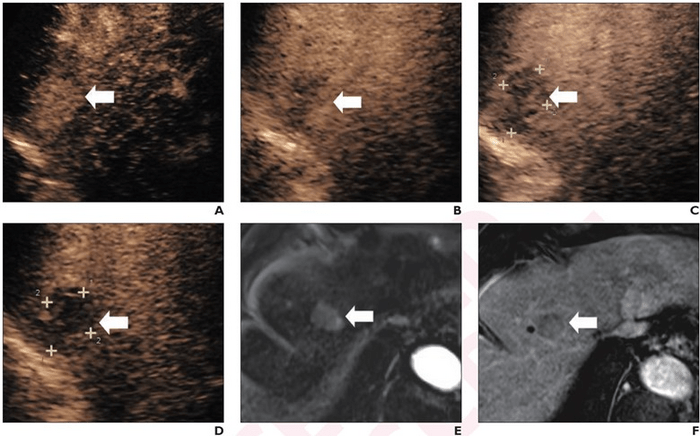Leesburg, VA, November 16, 2022—According to an accepted manuscript published in ARRS’ American Journal of Roentgenology (AJR), diagnostic performance of LR-5 for hepatocellular carcinoma (HCC) diagnosis was not significantly different between modified contrast-enhanced ultrasound (CEUS) using perfluorobutane and CT/MRI LI-RADS version 2018.
“The findings support the application of modified CEUS criteria using perfluorobutane for diagnosing HCC in high-risk patients,” wrote Jianhua Zhou, MD, PhD, of Sun Yat-Sen University Cancer Center’s State Key Laboratory of Oncology in Guangzhou, South China.
In this AJR accepted manuscript, 171 patients (140 men, 31 women; mean age, 54 years) at high risk for HCC with a pathologically confirmed liver observation were evaluated by both CEUS using perfluorobutane and contrast-enhanced CT or MRI, between March 2020 and May 2021. A matching algorithm was used to select 2 patients with HCC for each patient with a non-HCC lesion. Two readers evaluated observations using proposed modifications to CEUS LI-RADS version 2017 that classify certain observations as LR-5—rather than LR-4 or LR-M, based on presence of defect post-perfluorobutane administration.
Ultimately, modified CEUS criteria using perfluorobutane and CT/MRI LI-RADS v2018 showed no significant difference in sensitivity (92.1% vs. 89.5%), specificity (87.9% vs. 84.2%), or accuracy (90.6% vs. 87.7%) of LR-5 for HCC. All observations assigned LR-4 (n=5) or LR-M (n=6) by CT/MRI LI-RADS v2018 but LR-5 by modified CEUS were HCC.
“Modified CEUS criteria performed similarly as CT/MRI LI-RADS v2018 and additional HCCs in a subset of observations assigned LR-4 or LR-M by CT/MRI LIRADS v2018,” the authors of this AJR accepted manuscript reiterated.
An electronic supplement to this AJR accepted manuscript is available here.
North America’s first radiological society, the American Roentgen Ray Society (ARRS) remains dedicated to the advancement of medicine through the profession of medical imaging and its allied sciences. An international forum for progress in radiology since the discovery of the x-ray, ARRS maintains its mission of improving health through a community committed to advancing knowledge and skills with the world’s longest continuously published radiology journal—American Journal of Roentgenology—the ARRS Annual Meeting, InPractice magazine, topical symposia, myriad multimedia educational materials, as well as awarding scholarships via The Roentgen Fund®.
MEDIA CONTACT:
Logan K. Young, PIO
44211 Slatestone Court
Leesburg, VA 20176
703-858-4332
lyoung@arrs.org
Journal
American Journal of Roentgenology
DOI
10.2214/AJR.22.28420
Method of Research
Imaging analysis
Subject of Research
People
Article Title
Intraindividual Comparison of Contrast-Enhanced Ultrasound Using Perfluorobutane With Modified Criteria Versus CT/MRI LI-RADS Version 2018 for Diagnosing HCC in High-Risk Patients
Article Publication Date
16-Nov-2022
















